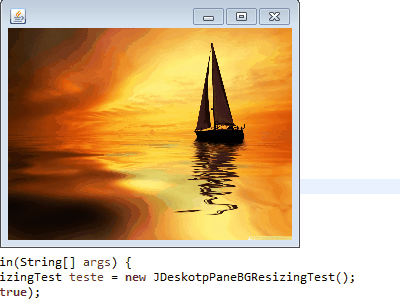5
I have code to add a background image to a JDesktopPaneand it works perfectly on widescreen 16:10 screens. However, when the screen is a little wider (16:9), it does not fill the rest of the background. I’ve seen some other possible ways to do it, but they make the picture lose a lot of quality, because they just stretch it out.
Is it possible to make a middle ground ? something that fills when necessary, and that there is not so significant loss in the image?
package novo;
import java.awt.Dimension;
import java.awt.Graphics;
import java.awt.Image;
import javax.swing.ImageIcon;
import javax.swing.JDesktopPane;
import javax.swing.JFrame;
import javax.swing.JOptionPane;
public class TesteJDP extends JFrame {
private static MeuJDesktopPane jdp = new MeuJDesktopPane();
public TesteJDP() {
getContentPane().add(jdp);
setSize(500, 450);
setLocationRelativeTo(null);
setDefaultCloseOperation(EXIT_ON_CLOSE);
}
public static void main(String[] args) {
TesteJDP teste = new TesteJDP();
teste.setVisible(true);
}
}
class MeuJDesktopPane extends JDesktopPane {
private Image imagem;
public MeuJDesktopPane() {
try {
imagem = new ImageIcon(getClass().getResource("/imagens/fundo.png")).getImage();
} catch (Exception e) {
JOptionPane.showMessageDialog(null, "Não foi possivel ler a imagem !");
}
}
@Override
public void paintComponent(Graphics g) {
super.paintComponent(g);
Dimension dimension = this.getSize();
int x = (int) (dimension.getWidth() - imagem.getWidth(this)) / 2;
int y = (int) (dimension.getHeight() - imagem.getHeight(this)) / 2;
g.drawImage(imagem, x, y, imagem.getWidth(this), imagem.getHeight(this), this);
}
}

The middle term you already answered, fix the window size as the image or put a larger image.
– user28595
@diegofm has tried to put a very large image, I do not know what happens, it does not fill everything. There’s no way to add some dimension or something to fill in ?
– Java
What are the dimensions of the image?
– user28595
@diegofm 2.362 px X 1.570 px
– Java
Your window is only (500, 450) in size, as a 3x larger image does not fill everything?
– user28595